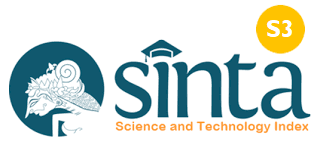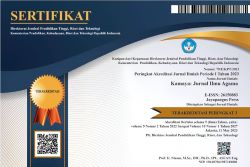Makna Simbolisasi Ayam Dalam Upacara Agama Dan Keagamaan Masyarakat Hindu Di Kabupaten Gianyar Bali
Abstract
This research is a merger of library research (library research) with a philosophical view on the field. The material objects are chicken symbols in every religious and religious ceremony in Hindu society in Bali, while the formal object is the philosophy of religion. The combination of this research is to provide a new understanding of the conception of Hindu societies in Bali about the meaning of symbols and their importance to the life of mankind.
This research was conducted to answer problems related to the use of symbols in the traditions of religious rituals and religious traditions of the Hindu community. In more detail, this research is to answer questions about what the symbolic meaning of chickens in the religious and religious life of the Hindu community in Bali and how the influence of the use of symbolic chicken in the religious life of the Hindu community. Disclosure of the meaning contained in the symbolization of the chicken is to show the strength of the relationship between religion and culture in every tradition in Hindu society.
The meaning contained in the symbolization of chicken shows three levels of human symbols, namely ethical, aesthetic and religious levels. Symbolization of chickens shows a tendency towards harmonizing human relations both horizontally (social harmonization) and transcendental vertical (relationship with God Almighty). In expressing the meaning in each chicken use in religious and religious ceremonies, it is used as an approach, such as a description to reveal what it is about symbolizing chickens. Interpretation and hermeneutics to provide an interpretation of the meaning in the use of chicken symbolization and heuristics used to form a comprehensive view of life in Hindu society.
References
Eliade, Mircea, 1974, Patterns in Comperatie Religion terjemahan, Rosemary Sheed, Sheed and Werd Press, London.
Geertz Cliifford,1992, Tafsir Kebudayaan, Refleksi Budaya, Kanisius, Yogyakarta.
Geertz Cliifford, Kebudayaan dan Agama, Refleksi Budaya, Kanisius, Yogyakarta.
Hans J. Daeng, 200, Manusia dan Kebudayaan dan Lingkungan, Tinjauan Antropologi, Pustaka Pelajar, Yogyakarta.
Pendit, Nyoman S, 1979, Bhagawad Gita, Depag Pusat, Jakarta.
Pudja, Gde, 1985, Sarasamuscaya, Mayangsari, Jakarta.
Putera, I.G. Ag, Mas, 1985, Upacara Dewa Yadnya, Yayasan Dharma Putra, Jakarta.
Putera, Tanpa tahun, Cudamani, Kumpulan Kuliah-Kuliah Adat Agama Jilid I, tanpa penerbit.
Siswanto, Joko,” Metafisika Wayang, Dimensi Ontologis Wayang sebagai Simbol Kehidupan” dalam Jurnal Fifsafat, Edisi April 2003, Fakultas Filsafat UGM Yogyakarta.
Titib, I Made,2003, Teologi dan Simbol-Simbol Dalam Agama Hindu, Paramita, Surabaya.
Triguna, Gde Yudha, 1994, “Pergeseran dalam Pelaksanaan Agama Menuju Tattwa” dalam I Gde Pitana, ed,1994, Dinamika Masyarakat dan Kebudayaan Bali, BP, Denpasar Bali.
Triguna, Gde Yudha, 2000, Teori tentang Simbol, Widya Dharma, Denpasar.
Lontar
Transkripsi Lontar Tingkahing Caru, Koleksi Pusat Dokumentasi kebudayaan Bali Denpasar.
Transkripsi lontar pelelintangan, Koleksi Sri Mpu Paramadaksa, Br. Penganbengan Desa Bongkasa Abiansemal Kabupaten Badung.
Downloads
Published
How to Cite
Issue
Section
License
An author who publishes in the Kamaya : Jurnal Ilmu Agama agrees to the following terms:
- Author retains the copyright and grants the journal the right of first publication of the work simultaneously licensed under the Creative Commons Attribution-ShareAlike 4.0 License that allows others to share the work with an acknowledgement of the work's authorship and initial publication in this journal
- Author is able to enter into separate, additional contractual arrangements for the non-exclusive distribution of the journal's published version of the work (e.g., post it to an institutional repository or publish it in a book) with the acknowledgement of its initial publication in this journal.
- Author is permitted and encouraged to post his/her work online (e.g., in institutional repositories or on their website) prior to and during the submission process, as it can lead to productive exchanges, as well as earlier and greater citation of the published work (See The Effect of Open Access).
Read more about the Creative Commons Attribution-ShareAlike 4.0 Licence here: https://creativecommons.org/licenses/by-sa/4.0/.





